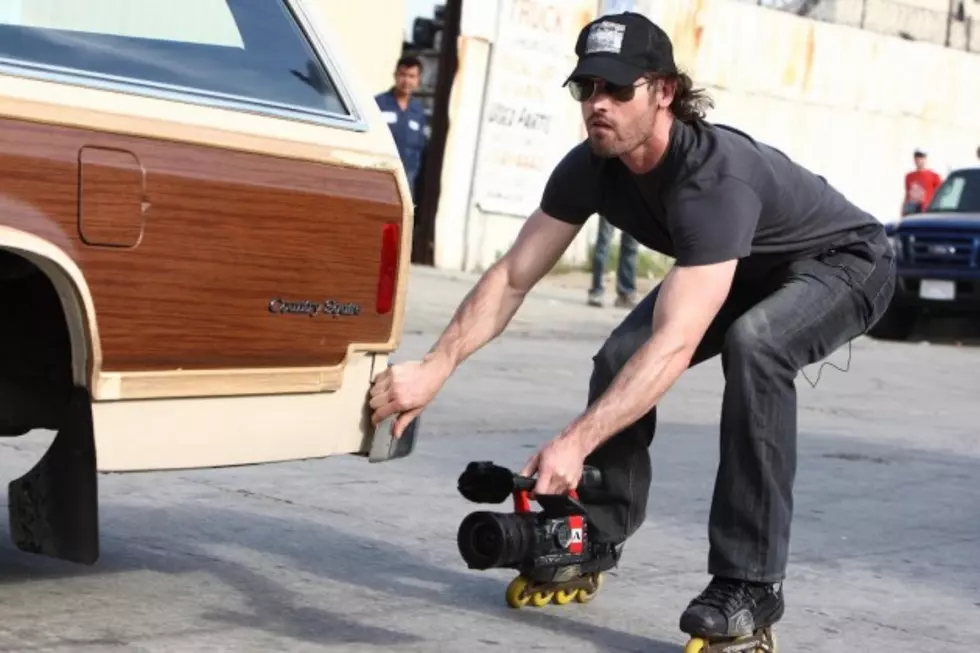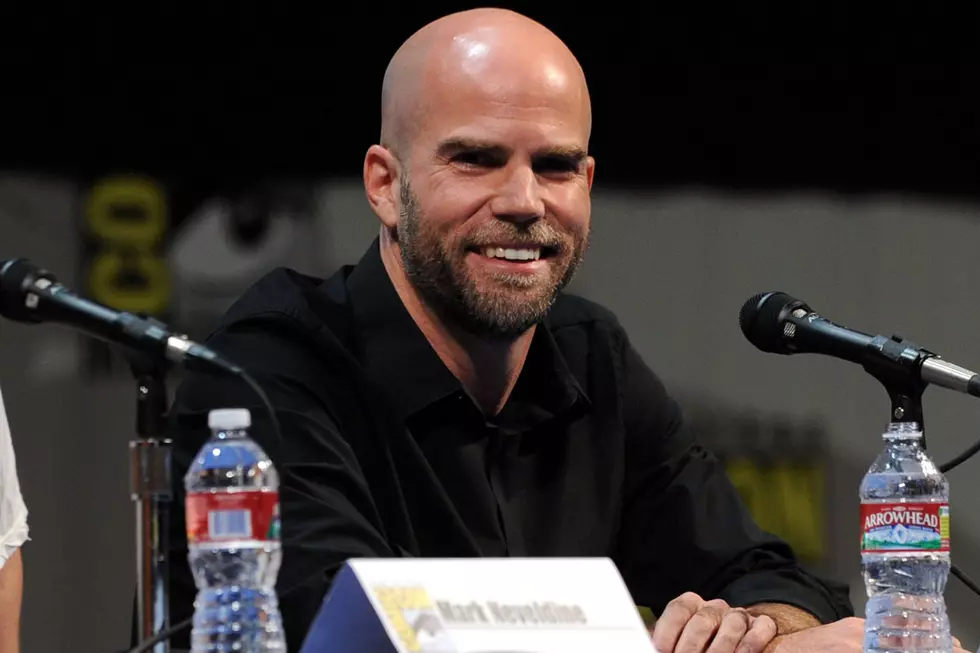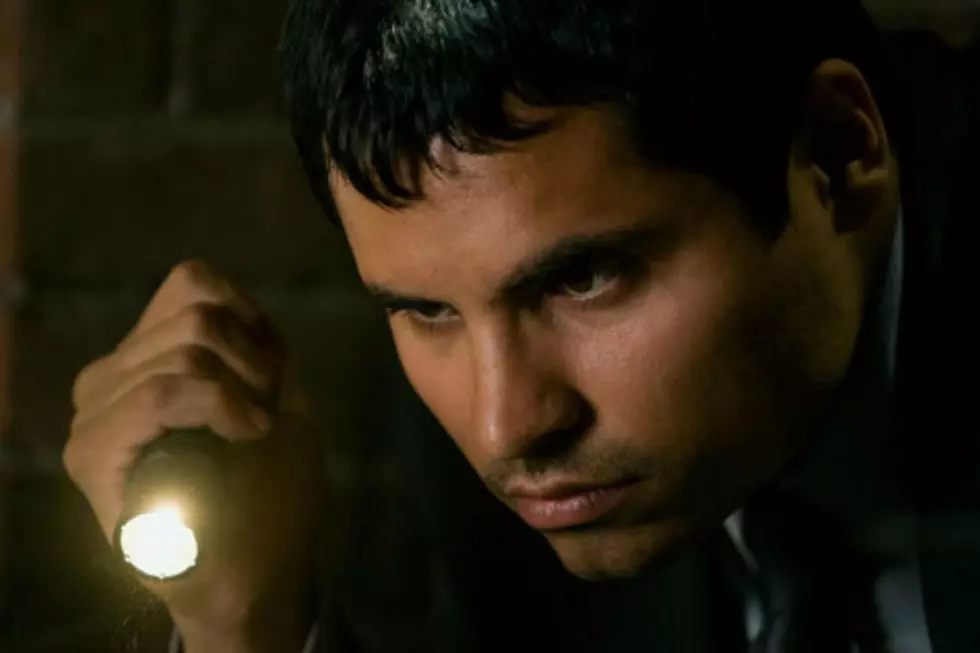
Mark Neveldine on ‘The Vatican Tapes,’ Remaking ‘The Warriors,’ and the Future of Neveldine/Taylor
Mark Neveldine is an action guy. In fact, as anyone who’s seen films like Crank and Gamer can attest, he’s one of the best and most distinctive action guys in Hollywood, with a frenetic but lucid style heavy on practical effects and dark humor. When I talked to Neveldine over the phone yesterday, he said he was “really close” to figuring out his next directing gig, one he promised would “definitely be an in-camera action film.”
For the moment, though, Mark Neveldine’s trying something different. He’s got a short story in the brand-new Blumhouse Book of Nightmares. And The Vatican Tapes, which opens in theaters this Friday, is both his first horror film and his first solo directorial effort without his longtime collaborator, Brian Taylor. It follows an innocent young woman (Olivia Taylor Dudley) who begins exhibiting bizarre and dangerous behavior. When she lands in a local hospital, the chaplain (Ant-Man’s Michael Peña) begins to suspect her mental illness might be more satanic in nature. Could she be possessed? (I will give you one clue: The film is called The Vatican Tapes, referring to the Catholic Church’s archive of evidence regarding demonic possession. So yes. Yes, she could be.)
It’s a classic exorcism story with a couple surprising twists, plus Neveldine’s unique visual flair. Even if you didn’t know he directed it, fans of Neveldine’s films will recognize his hand in The Vatican Tapes just from the gliding, surreal camera moves (which are shot by Neveldine himself, on rollerblades). On the eve of The Vatican Tapes’ release, I talked to Neveldine about achieving those distinctive shots, the essential elements of exorcism movies, whether he plans to re-team with Brian Taylor in the future, and the surprising remake he’s interested in directing.
Exorcism movies are one of the most enduringly popular horror sub-genres. Why do you think people continue to love them?
People love being scared. They love going to a movie, whether it’s for a date night or just to raise their adrenaline, and exploring the dark side now and again.
What in your mind were the essential elements of making an exorcism movie? Obviously an exorcism — but what specific shots or set pieces or visuals did you feel you had to include to fulfill audiences’ expectations?
It’s interesting. When I read the script that Christopher Borrelli and Michael C. Martin wrote, it had some of those elements; it touched on things of the past like The Exorcist or Rosemary’s Baby. But I liked that there wasn’t a Ouija board, there wasn’t a demonized pendant. Simply, Angela’s sin — you always need a sin — her sin was that she was human. And that the devil could choose anybody. I thought that was pretty neat. I also liked that this movie is this tiny little slice-of-life possession film, but what it really is is an origin story that flies underneath a possession film. That’s really what this thing is. It starts off small and it goes much bigger.
You mention the script, and I saw online that it was selected for The Black List in 2009 — but the description that was on The Black List website is actually pretty different from the finished film. Was their synopsis inaccurate or was the script revised?
It’s a little bit of both. When Lakeshore gave me this script, first of all ... I loved it. But it was a found-footage movie. [Producers] Tom Rosenberg and Gary Lucchesi said, “We’re not interested in a found-footage movie. We’re interested in the cinematic version of this movie.” So what we had to do is change the P.O.V. of the movie and make this more of a character piece. So it was challenging and it was fun. And I’ve been involved in a billion movies that are like “Hey, let’s just take this and make it found footage because we have no money! And we’ll just use these iPhone cameras! It’ll be great!” I think this is the first time, that I know of, that a found-footage movie was reverse engineered into a cinematic experience. It was definitely a trip.
I’ve always wanted to dive into a thriller in this way. I grew up Catholic. As a kid, I read the Catechism. I read the Rite of Exorcism when I was younger. I was terrified then and I’m terrified now of the devil. So it was fun for me to tackle this. It was definitely a challenge, and my friends were like “Dude, why are you doing this?” And I’m like, “I’m doing it cause I really kind of like it, and I want to stretch my muscles and get off my rollerblades for five seconds and put a camera on a tripod and do something different.”
That said, some of my favorite moments in The Vatican Tapes are the ones where I really see your visual signature; those hallway shots following people as they’re running. What is it that makes those shots so distinctive? Is it a particular filter or lens or frame rate or a combination?
[laughs] Okay, so I did hop on my rollerblades a couple of times on this movie, and those running shots I was filming on rollerblades. Something I also like to do — and I was doing this way back when when I was a kid — I definitely like to find the right shutter rate. So a lot of this film we were at 250 or 500. I like to give it that little frenetic edge, especially when we get to the moments that are terrifying. I want to build that up. But that’s kind of the look. You’re kind of seeing this floaty roller-cam thing, mixed with a high shutter speed.
As more time goes on, I feel like Ghost Rider: Spirit of Vengeance looks better and better, because it’s so weird in a genre that’s getting pretty homogenized. Do you think you’d be able to make your Ghost Rider in this current superhero movie environment?
It’s funny; that’s the way that Brian [Taylor] and I see the world. There are people who enjoyed it and people who didn’t; it was our take on it, y’know? The only thing ... I don’t regret it, because that was a super-fun movie to do, but I wish we would have seen the bigger picture and stuck with the rated-R version of that movie because it would have been fun. But people were so terrified of what we were going to do. Even with a PG-13 version, in our studio meetings we were talking about such a dark version of Ghost Rider. It’s sad, because I think the rated-R version would be even more timeless.
Are ratings something you’re constantly struggling with? Ghost Rider was PG-13 and The Vatican Tapes is too, but all you early movies were definitely R-rated. Is that just the way of Hollywood now? Do you have to be PG-13 these days?
You don’t have to; you can always make those choices. We signed on to [Ghost Rider] as a PG-13 movie; we toyed with “Oh, can we go back to R?” When I signed on to The Vatican Tapes it was definitely PG-13, and in a way I was okay with that. I was like “This is going to be incredibly challenging, but I can’t just go out and use sex, drugs, and rock and roll to scare people or amp people up. I need to do something a little bit different here.” So I enjoyed that challenge.
That said, I’m super-excited about diving back into R-rated films. I just produced a film called Officer Downe that Kim Coates starred in, and it is super hard R. And it fit that movie. The Vatican Tapes is perfectly awesome as a PG-13 movie.
I saw Chris Morgan listed in The Vatican Tapes credits as a story co-writer, and I love his work on the Fast & Furious franchise. I’m curious about your thoughts on the state of the action movie right now, as a guy who’s made some of my favorites of the last decade or so, and seems to be more interested in the practical side of things than most current action filmmakers, who rely so heavily on CGI.
I’m a giant fan of the Fast & Furious franchise. I absolutely love it. And I love the way they do it; I love the use of CGI in it. They have fun with it. And Mad Max was awesome to me. But something that excites me as a filmmaker is different from what excites me as an audience member.
I’m a fan of all films. As a filmmaker, though, I really push myself to go back to ’70s style action films where it looks dangerous because it is dangerous. I want to get the camera in the action. I’ve passed on a couple things because I knew that I’d be sitting on a soundstage in front of a green screen, and my brain just shuts off. Maybe I’m not that mathematical. I just don’t like it, I don’t understand the blocking of it, it’s not really my thing. So I really want to focus on things where I can stick cameras on the cars or on the stuntmen and we can really crash the s—. That’s what interests me — but only as a filmmaker! As an audience member, man, again, Fast & Furious is really one of my favorite franchises of all time.
I often cite both Crank movies as the best video-game movies ever made — even though they’re not based on any specific games. As someone who’s done a good job of merging video game aesthetics with movies, can you explain why it’s so hard to make decent video-game movies?
Here’s the thing. We’ve had the luxury to create these video-game-type movies where we didn’t have studios breathing down our necks, or the IP owners saying “You have to do it this way!” and constrict you that way. So we really did have the freedom to make these action films the way that we loved; the heightened style, the comic-book feel, and definitely that video-game attitude. There’s really no filter for us when we wrote those film and when we directed those films.
I don’t envy having to take a giant video game that sold $4 billion worth of copies and have to engineer that into a movie. It’s got to be tough. We’ve been in rooms, and we’ve pitched a couple things like that, and it’s tough. I think if there was more freedom at the studio level and with the video game makers, I think that there could be some awesome movies based on games out there. But there’s too many cooks in the kitchen when they make those films. That’s my opinion, anyway.
So what is the status of the Neveldine/Taylor partnership? Is it a temporary break while you guys do solo stuff or are you permanently going your separate ways?
We’re definitely gonna do solo films. But we have an approved treatment for Crank 3 and we’re super-excited about it. I know we’ve talked about it in the past, but we had lunch with Jason [Statham], we had lunch with Lakeshore. Everybody wants to do it, it’s just now about all the stars aligning.
Brian and I have a couple things that we’d really like to do as a team, and there are projects that really make sense that way. But also everybody thinks we’re just one person. We’re actually two guys with families and kids now, and we have things that we want to do solo and we’re very supportive of each other doing that. But we want to do Crank 3 and I’ve said before that The Warriors would be a remake that Brian and I would love to tackle, it’s just in rights hell at the moment.
This is the Walter Hill Warriors?
Yes.
That’s something you’d want to remake?
We have never been interested in remakes, and probably still aren’t. But that’s the one that we’ve always felt would just be awesome. We just feel like we’re the perfect guys for that job; baseball bats, roller-skates, gangs, the heightened world. We know there’s been fear at some studios like “We make this movie today and gangs are gonna go wild!” And it’s like “Whatever.” You do it in Crank style, people are just gonna laugh and have fun.
People were worried a Warriors remake could lead to a rise of gang violence?
Yes.
[Laughs] So if you did remake The Warriors, what would be the Neveldine/Taylor twist to it all?
Well we would set it, obviously, five minutes in the future, and we’d really love to build these flamboyant gangs and have fun with them, and have a heightened sense of action and bring all the things that we’ve learned and stolen from Rodriguez and Tarantino and other great directors and put it on the screen. [laughs]
That sounds pretty intriguing actually. I’m also intrigued to hear you talk about you and Brian as a partnership that’s viewed by a lot of people as one director when you’re actually two guys with different interests. How would you say you’re different from Brian in terms of your tastes or style?
It’s funny because when we’re doing our films together we’re both directors who are directors of photography, who are camera operators, who have gaffed at some point in our lives. We’re also writers and we also edit. So we’ve done all that stuff and when we’re together we just merge; our anxieties and effed-up minds are very similar in a way. We’re different only in that there’s some things that as far as the style of films that maybe we want to do. Brian would be interested — maybe not in a totally CG film, but he’s not afraid of CG. He’s not afraid of that sort of world, and maybe I am. It’s who we are as people. But it’s such a hard to question to answer. It really is. At the end of the day, we want to do our own stuff, but we also want to make some rad movies together.
More From ScreenCrush









